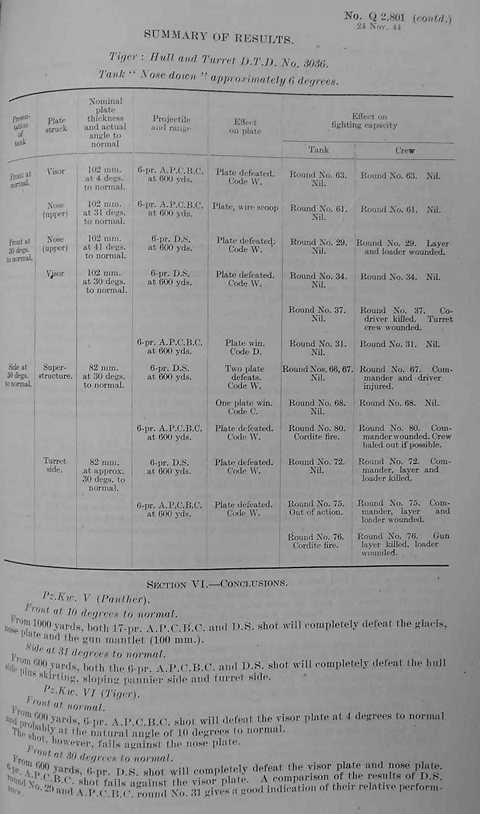Hello,
It would be nice yo know what knid of tests were done in the areas of tanks and armor during WW2. The information available online almost always refers to tests done by each country in particular. So the 76mm of the Sherman was tested against US homogenous steel. The Churchill's 57mm, also, against British plates; German 88mm against German plates, and so on.
I have 2 examples of cross-checking, and maybe somebody can add more:
- 1943 testing of Tiger 80mm plate by the British found it to be as resistant to penetration as a British 92mm plate
http://www.fprado.com/armorsite/tiger1.htm
- German Army data on the penetration ranges of the 122 mm A-19 (JS-2 gun) against the Panther tank showed it to be much less effective when the Panther stood at a side angle of 30 degrees to the incoming round: the A-19 gun was unable to penetrate the glacis plate of the Panther at any distance, and could only penetrate the bottom front plate of the hull at 100 m.[3]
http://en.wikipedia.org/wiki/Iosif_Stalin_tank#IS-2
Ballistic tests of WW2 tanks
-
alecsandros
- Senior Member
- Posts: 4349
- Joined: Wed Oct 14, 2009 2:33 pm
- Location: Bucharest, Romania
-
Byron Angel
- Senior Member
- Posts: 1658
- Joined: Sun Mar 06, 2011 1:06 am
Re: Ballistic tests of WW2 tanks
alecsandros wrote:Hello,
It would be nice yo know what knid of tests were done in the areas of tanks and armor during WW2. The information available online almost always refers to tests done by each country in particular. So the 76mm of the Sherman was tested against US homogenous steel. The Churchill's 57mm, also, against British plates; German 88mm against German plates, and so on.
I have 2 examples of cross-checking, and maybe somebody can add more:
- 1943 testing of Tiger 80mm plate by the British found it to be as resistant to penetration as a British 92mm plate
http://www.fprado.com/armorsite/tiger1.htm
- German Army data on the penetration ranges of the 122 mm A-19 (JS-2 gun) against the Panther tank showed it to be much less effective when the Panther stood at a side angle of 30 degrees to the incoming round: the A-19 gun was unable to penetrate the glacis plate of the Panther at any distance, and could only penetrate the bottom front plate of the hull at 100 m.[3]
http://en.wikipedia.org/wiki/Iosif_Stalin_tank#IS-2
..... Jentz has touched upon some aspects of this topic in several of his books. In his book on the North African campaign, he discusses the face-hardened applique plates applied to the frontal armor of German Mk IIIs and Mk IVs which would shatter British uncapped 2-lbr AP shot within a certain range/striking velocity band. At various points in his other books (Panzer Truppen, Tiger I, Panther) he gives German data on the range limits at which foreign AP weapons could penetrate various points (mantlet, upper hull glacis, lower hull, turret side, etc) on German tanks and vice versa for German guns versus opposing tanks.
I have not seen any US work in this area, perhaps because typical production Shermans were so highly vulnerable to German anti-tank weapons in general. One only discovers anecdotal snippets - such as the observation that, even at ranges in excess of 1,000 yards, an 88mm projectile could pass entirely through a Sherman tank. Belton Cooper discusses one such episode in some detail in his book "Death Traps".
B
-
Byron Angel
- Senior Member
- Posts: 1658
- Joined: Sun Mar 06, 2011 1:06 am
Re: Ballistic tests of WW2 tanks
Go here -
http://www.wlu.ca/lcmsds/cmh/back%20iss ... 201944.pdf
- for another interesting item: "Analysis of 75mm Sherman Tank Casualties Suffered between 6th June and 10-th July 1944". Pretty dramatic statistics.
B
http://www.wlu.ca/lcmsds/cmh/back%20iss ... 201944.pdf
- for another interesting item: "Analysis of 75mm Sherman Tank Casualties Suffered between 6th June and 10-th July 1944". Pretty dramatic statistics.
B
-
steffen19k
- Member
- Posts: 77
- Joined: Fri Jun 08, 2012 5:31 pm
Re: Ballistic tests of WW2 tanks
You know, the most useful test you could perform is generally the most dangerous. Take your tank into battle, and see how it holds up against what the other guys are shooting. Its known as empirical data.
Other than that, what you could try is using Nathan Okun's basic mathematic formulae from when he analyzed the battleships of the US, UK, IJN, KM, and Italian Navies, at the nav weaps site.
The only thing I will note here is that WW2 tank armor is the same material as battleship armor, just thinner, and less varied.
Generally speaking (and I do mean as a generalization) US WW2 cast tank armor came from General Steel Castings, the same people who made the Battleship Armor of the fast battleships. Rolled homogeneous tank armor usually came from Bethlehem Steel.
Other than that, what you could try is using Nathan Okun's basic mathematic formulae from when he analyzed the battleships of the US, UK, IJN, KM, and Italian Navies, at the nav weaps site.
The only thing I will note here is that WW2 tank armor is the same material as battleship armor, just thinner, and less varied.
Generally speaking (and I do mean as a generalization) US WW2 cast tank armor came from General Steel Castings, the same people who made the Battleship Armor of the fast battleships. Rolled homogeneous tank armor usually came from Bethlehem Steel.
Here is everything I know about war: Someone wins, Someone loses, and nothing is ever the same again. Here is everything I know about life: The only certainties are death and taxes.
The enemy of freedom are those who proclaim only they can uphold it.
The enemy of freedom are those who proclaim only they can uphold it.
